Horse Discovery - Forage Identification and Use
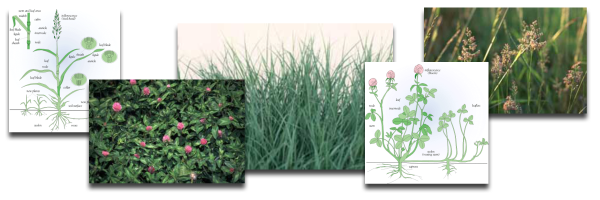
Forage Identification and Use
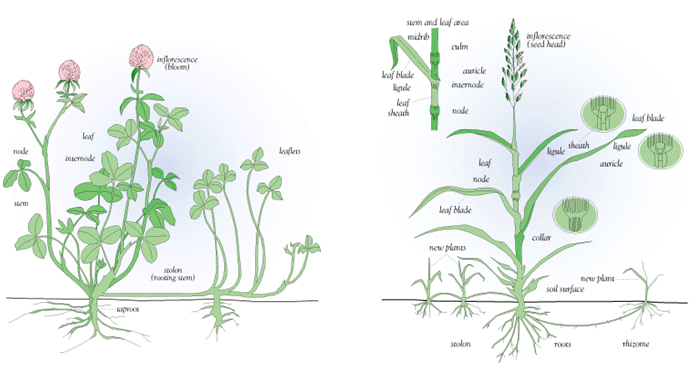
To properly manage and understand a forage system—whether it is used for hay, pasture, wildlife, conservation, or some combination of uses—it is important to be able to identify the species present and understand their establishment, management, and productivity. The following section includes photographs and descriptions of the major forage grasses and legumes for Kentucky and their definitive characteristics as well as some general guidelines for their establishment and use. Some characteristics and advantages are common to all grasses or legumes. For example, nearly all legumes are able to convert atmospheric nitrogen into plant-available nitrogen through Rhizobium bacteria in root nodules. Erosion control is a good example of a common benefit of most grasses. Such common traits will not be listed specifically for individual grasses or legumes unless they are major distinguishing uses or characteristics.
Forages by Type
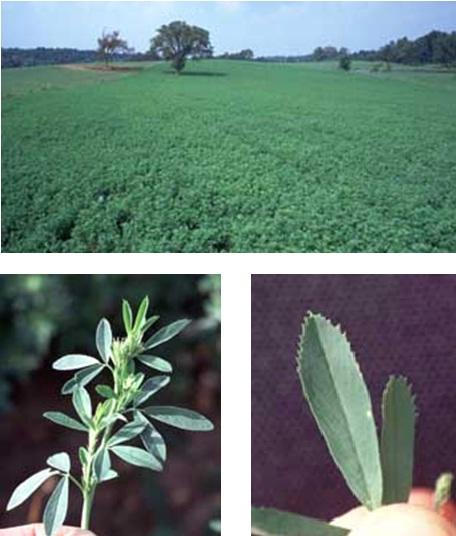
- Description: High-yielding, high-quality perennial legume with good summer production. Provides multiple cuttings during growing season. Grows 2 to 3 feet tall.
- Uses: Hay, haylage, pasture.
- Advantages: High yield and quality, more productive during summer than other cool-season forages. Palatable to livestock.
- Disadvantages: Requires well-drained, fertile soils and better management for good yield and persistence. Potential for bloat. Alfalfa weevil and potato leafhopper are economic pests.
- Seeding: Rate: 12-20 lb/a Depth: ¼-½ in Date: Mar 1-Apr 15/Aug 1-Sep 15
- Harvest: First harvest: May 1-May 15 Annual yield: 3-6 tons dry matter/a
Alfalfa leaflets are longer and narrower than red clover, do not have a prominent watermark, or V-shaped pattern, on the leaflets like red clover, and are serrated only at the tip. Alfalfa can have purple or yellow flowers.
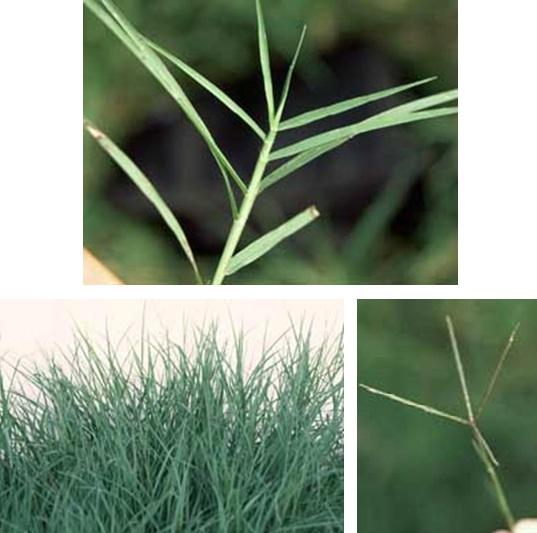
- Description: Sod-forming, warm-season, perennial grass that spreads by rhizomes, stolons, and seed (common types of bermudagrass spread this way). Extremely drought tolerant. Hybrid bermudas should be used because of their improved quality and palatability compared to common types.
- Uses: Hay and pasture.
- Advantages: High yielding and highly responsive to nitrogen applications. Grows well during summer. Good sod former.
- Disadvantages: Some varieties are more winter-hardy than others. Hybrids must be started from sprigs. Poor quality when overmature. Short growing season. Weeds can be a major problem during establishment.
- Seeding: Rate: 30-50 bushels of sprigs/aDepth: 1-2 inDate: Apr 15-Jun 15
- Harvest: First harvest: Jun 15-Jul 1Annual yield: 3-7 tons dry matter/a

- Description: Perennial, dark green, sod-forming grass with rhizomes, grows 1 to 3 feet in seed head stage. Leaves are narrow and fine bladed with tips shaped like a boat's bow.
- Uses: Pasture, with limited use for hay.
- Advantages: High quality, highly palatable, long-lived pasture plant. Tolerates close, frequent grazing better than most grasses. Forms tight sod.
- Disadvantages: Low yields, low summer production, becomes dormant and brown during hot, dry summers. More susceptible to grubs and insects than other pasture grasses. Slow to establish. Limited adaptation area (central, northern, and northeastern Kentucky).
- Seeding: Rate: 10-15 lb/a Depth: ¼-½ in Primary Date: Aug 15-Oct 1 Secondary Date: Feb 1-Apr 15
- Harvest: First harvest: May 1-May 15 Annual yield: 1-3 tons dry matter/a
Kentucky bluegrass leaves are dark green in color and are more narrow than either tall fescue or orchardgrass. The leaf tips of bluegrass are shaped like a boat's bow. No auricles, low ligule.
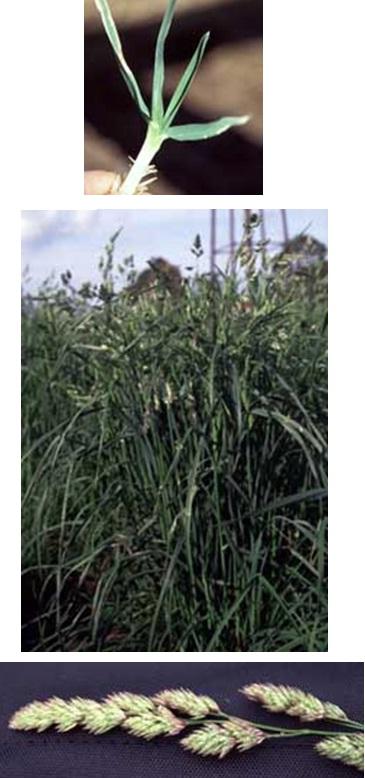
- Description: Perennial bunchgrass. Grows 2 to 5 feet in seed head stage. Has a swollen, bulblike structure at base of stem. Leaves have a bluish green color compared to tall fescue.
- Uses: Primarily a hay plant, but may be used for pasture when a part of a mixture.
- Advantages: Large, first-cutting yields, high demand for hay either pure or in mixtures, grows well with alfalfa and/or red clover. Good nutritive quality when first cutting made in boot to early head.
- Disadvantages: Short stand life, low quality when cut late, little regrowth after first cutting. Clumpy growth habit and sensitivity to hot temperatures limit its use in pasture.
- Seeding: Rate: 3-6 lb/a Depth: ¼-½ in Primary Date: Aug 15-Oct 1 Secondary Date: Feb 1-Apr 15
- Harvest: First harvest: May 15-June 1 Annual yield: 2-4 tons dry matter/a
The stem of orchardgrass is nearly flat at the base. It has a tall ligule but no auricles. Orchardgrass leaves are blue-green in color and emerge along the midrib of the leaf folded in half.

- Description: Cool-season, perennial legume with hairy stems. Stands last two to three years. Erect, leafy plant that grows 2 to 3 feet tall. Leaves are large and often have prominent V-shaped watermark.
- Uses: Hay, pasture, haylage.
- Advantages: Widely adapted, good seedling vigor, complements tall fescue and other cool-season grasses. Established easily, high yields.
- Disadvantages: Shorter stand life than alfalfa and white clover. Heavy first cuttings are difficult to cure. Hay is dusty. Overmature second cutting red clover hay may have a fungus that causes animals to slobber.
- Seeding: Rate: 8-12 lb/a Depth: ¼-½ in Primary Date: Feb 1-Apr 15 Secondary Date: Aug 1-Sep 15
- Harvest: First harvest: May 1-May 15 Annual yield: 2-5 tons dry matter/a
Red clover leaves are large and nearly always have a prominent V-shaped pattern, or watermark, on the leaflets. Red clover has very hairy, fleshy stems and dark, pink flowers. Red clover plants form crowns around a taproot and grow erect.
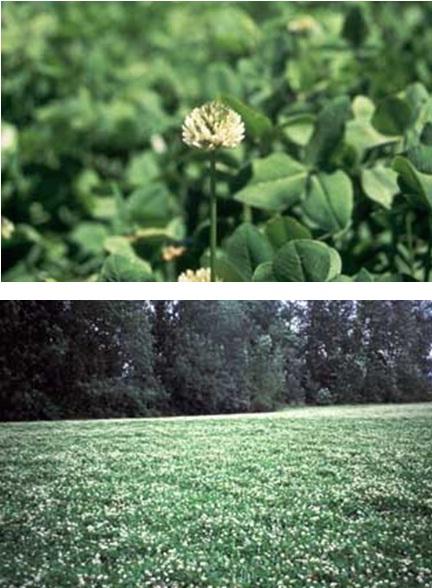
- Description: Long-lived perennial cool-season legume spread by stolons. Plants are leafy and are 8 to 12 inches tall. Leaves and stems are non-hairy. Ladino is a taller-growing form of white clover.
- Uses: Pasture and wildlife.
- Advantages: Ease of establishment into existing cool-season grasses. High quality and high animal acceptance. Long stand life. Tolerant of wide range of soil and climatic conditions (especially cool and wet). Good seed production under grazing.
- Disadvantages: Poor summer growth. Low yielding. Not good for hay. Potential for bloat (especially in spring and with thick, lush stands). Thick stands of established white clover can be extremely competitive with interseeded forages.
- Seeding: Rate: 1-3 lb/a Depth: ¼-½ in Primary Date: Feb 1-Apr 15 Secondary Date: Aug 1-Sep 15
- Harvest: First harvest: Not applicableAnnual yield: 1-3 tons dry matter/a
The leaves are shiny underneath, sometimes watermarked with a V-shaped pattern, and stems are often grooved. White clover leaves grow from stems (called "stolons") that run horizontally along the top of the ground. Unlike red clover, white clover does not have hairs.

- Description: Shiny, dark green, annual bunchgrass with smooth leaves. Grows 2 to 4 feet tall in seed head stage.
- Uses: Fall and winter pasture, hay, erosion control.
- Advantages: High nutritive quality and palatability, excellent seedling vigor, reseeds itself easily, tolerates close grazing.
- Disadvantages: Not always winter-hardy. Low quality after heading. Can be overly competitive in mixtures. Reseeds prolifically and can be a troublesome weed in crop fields.
- Seeding: Rate: 20-30 lb/a Depth: ¼-½ in Date: Aug 15-Oct 1
- Harvest: First harvest: Apr 20-May 15 Annual yield: 1-3 tons dry matter/a
Perennial ryegrass leaves vary from narrow and fine (like bluegrass) to broad and coarse like tall fescue. In all cases, leaves have a very waxy or shiny appearance. Perennial ryegrass has a distinct purpling at the base of the stem. Perennial ryegrass leaves are flattened in the bud, in contrast to annual ryegrass leaves, which come out rolled. By comparison, annual ryegrass heads typically have more florets per flower and usually have awns (fine hairs extending from the ends of each seed), while perennial ryegrass has fewer florets and doesn't have awns.
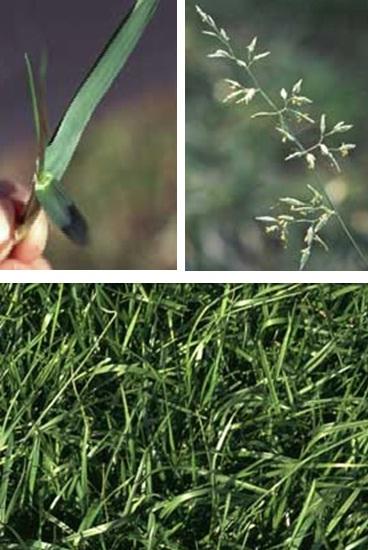
- Description: Perennial, long-lived bunchgrass with short rhizomes; shiny, dark green leaves with prominent veins. Grows 2 to 4 feet tall in seed head stage. Tolerant of soil acidity, low fertility, and poor drainage, and relatively tolerant of drought and overgrazing. Most older fields are infected with an endophytic fungus, which reduces animal performance but aids in survival of plant.
- Uses: Pasture, hay, erosion control.
- Advantages: Tolerant of low fertility and acidic soils, well suited for winter stockpiling, long growing season. Endophyte-infected varieties are more tolerant of overgrazing than any other forage. Endophyte-free tall fescues are available and result in better animal performance. Generally not affected by insects and diseases.
- Disadvantages: Endophyte-infected plants hinder animal performance. Low-endophyte varieties must be well managed (not overgrazed) for persistence. All tall fescue produces minimal growth in hot, dry conditions.
- Seeding: Rate: Rate: 15-20 lb/a Depth: 1/3-1/2 in Primary Date: Aug 15-Oct 1 Secondary Date: Feb 1-Apr 15
- Harvest: First harvest: May 1-15 Annual yield: 2-4 tons of dry matter/a
Tall fescue has thick, wide leaves with prominent veins, and the emerging leaves are rolled in the bud. There is no obvious ligule.
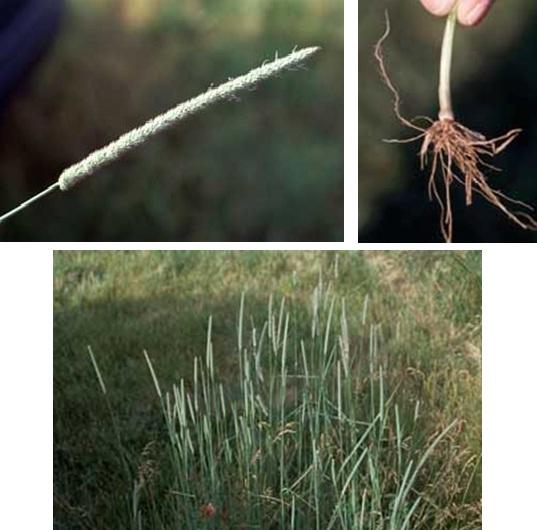
- Description: Perennial bunchgrass. Leaves have bluish green color compared to tall fescue. Leaf veins are much less prominent compared to tall fescue. Grows 2 to 4 feet tall in seed head stage, stems are flattened at the base. Leaves emerge from stem base folded.
- Uses: Hay, pasture.
- Advantages: High quality and high yields, more likely to get summer cuttings. Palatable to livestock, in high demand for hay. Well suited for use in mixtures with alfalfa and red clover.
- Disadvantages: Seed heads in many varieties can appear in late April, which is a difficult time to get hay cured without rain damage. Stands become clumpy with age and have a short life (usually less than five years). Not tolerant of close cutting or continuous close grazing. Susceptible to leaf diseases.
- Seeding: Rate: 10-15 lb/a Depth: ¼-½ in Primary Date: Aug 15-Oct 1 Secondary Date: Feb 1-Apr 15
- Harvest: First harvest: May 1-20 Annual yield: 2-4 tons dry matter/a
Timothy has a very recognizable cylindrical seed head and a corm, or bulb, just above the roots.

Once you have read through the Forages section on our Horse Discovery page, you can test your knowledge here. The quiz will provide automatic grading and reveal the correct answers for learning purposes.
Take the Forages Knowledge Check here.
Did you score an 80% or higher? Congratulations! Email anna.draeger@uky.edu with a screenshot of your score to receive your celebratory Certificate of Completion for the Forages section.
Horse Discovery Navigation |
